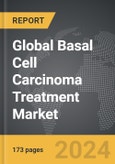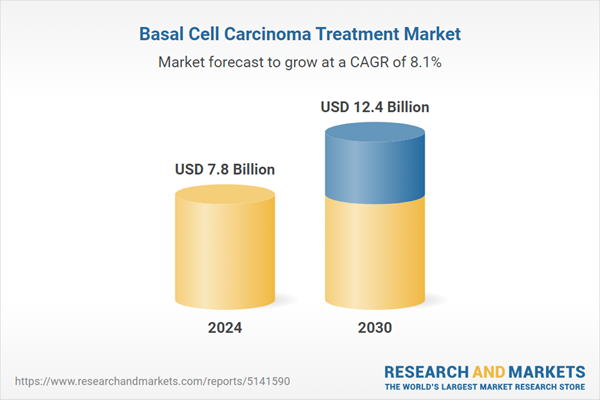Global Basal Cell Carcinoma Treatment Market - Key Trends & Drivers Summarized
What Is Driving the Growing Focus on Basal Cell Carcinoma Treatment?
Basal cell carcinoma (BCC), the most common form of skin cancer, has seen a rise in incidence globally, driven by factors such as increased exposure to UV radiation and an aging population. BCC is primarily caused by prolonged exposure to sunlight, and while it is rarely life-threatening, early detection and treatment are crucial to prevent the cancer from spreading or causing significant tissue damage. The growing prevalence of BCC has led to heightened awareness and increased demand for effective treatments. This has, in turn, spurred significant advancements in therapeutic options, ranging from topical treatments and surgical excision to more advanced targeted therapies.What Are the Current Treatment Trends for Basal Cell Carcinoma?
Treatment for basal cell carcinoma has evolved significantly in recent years, with a growing focus on non-invasive and patient-friendly options. Surgical excision remains the most common treatment, particularly for early-stage BCC, offering a high cure rate. However, the development of new topical treatments, such as imiquimod and 5-fluorouracil, provides non-surgical alternatives for patients with superficial BCC. Moreover, innovations in radiation therapy, such as stereotactic body radiation therapy (SBRT), allow for precise targeting of cancerous tissues, reducing damage to surrounding healthy cells. For more advanced or recurrent cases, targeted therapies like hedgehog pathway inhibitors (e.g., vismodegib and sonidegib) have proven effective, specifically targeting the genetic mutations that drive BCC growth.How Are Innovations in Cancer Treatment Driving Market Growth?
The landscape of basal cell carcinoma treatment has been transformed by the advent of precision medicine and targeted therapies. Hedgehog pathway inhibitors represent a major breakthrough in the treatment of advanced BCC, particularly for patients who are not candidates for surgery or radiation. These drugs specifically target the molecular pathways involved in BCC development, offering a personalized approach to treatment. Additionally, ongoing research into immunotherapy has the potential to further revolutionize the market. Clinical trials are exploring the use of immune checkpoint inhibitors to boost the body's immune response against BCC, providing new hope for patients with aggressive or metastatic forms of the disease. These advancements are expanding treatment options and improving patient outcomes.The Growth in the Basal Cell Carcinoma Treatment Market Is Driven by Several Factors
The growth in the basal cell carcinoma treatment market is driven by several factors, including the rising incidence of skin cancer, advances in targeted therapies, and increasing demand for non-invasive treatment options. The aging population and heightened awareness of the dangers of sun exposure are leading to earlier detection and higher diagnosis rates, which in turn are fueling the demand for effective treatments. Technological innovations in radiation therapy and minimally invasive surgical techniques are also playing a crucial role in market expansion. Additionally, the approval of targeted therapies such as hedgehog pathway inhibitors has provided a treatment option for patients with advanced BCC, further boosting market growth. Increased investment in research and development, coupled with growing patient awareness, is expected to sustain the momentum of the basal cell carcinoma treatment market.Report Scope
The report analyzes the Basal Cell Carcinoma Treatment market, presented in terms of market value (US$ Thousand). The analysis covers the key segments and geographic regions outlined below.- Segments: End-Use (Hospitals, Specialty Clinics, Other End-Uses); Treatment Type (Surgery, Drugs, Other Treatment Types).
- Geographic Regions/Countries:World; United States; Canada; Japan; China; Europe (France; Germany; Italy; United Kingdom; Spain; Russia; and Rest of Europe); Asia-Pacific (Australia; India; South Korea; and Rest of Asia-Pacific); Latin America (Argentina; Brazil; Mexico; and Rest of Latin America); Middle East (Iran; Israel; Saudi Arabia; United Arab Emirates; and Rest of Middle East); and Africa.
Key Insights:
- Market Growth: Understand the significant growth trajectory of the Surgery segment, which is expected to reach US$7.6 Billion by 2030 with a CAGR of a 8.7%. The Drugs segment is also set to grow at 7.5% CAGR over the analysis period.
Why You Should Buy This Report:
- Detailed Market Analysis: Access a thorough analysis of the Global Basal Cell Carcinoma Treatment Market, covering all major geographic regions and market segments.
- Competitive Insights: Get an overview of the competitive landscape, including the market presence of major players across different geographies.
- Future Trends and Drivers: Understand the key trends and drivers shaping the future of the Global Basal Cell Carcinoma Treatment Market.
- Actionable Insights: Benefit from actionable insights that can help you identify new revenue opportunities and make strategic business decisions.
Key Questions Answered:
- How is the Global Basal Cell Carcinoma Treatment Market expected to evolve by 2030?
- What are the main drivers and restraints affecting the market?
- Which market segments will grow the most over the forecast period?
- How will market shares for different regions and segments change by 2030?
- Who are the leading players in the market, and what are their prospects?
Report Features:
- Comprehensive Market Data: Independent analysis of annual sales and market forecasts in US$ Million from 2024 to 2030.
- In-Depth Regional Analysis: Detailed insights into key markets, including the U.S., China, Japan, Canada, Europe, Asia-Pacific, Latin America, Middle East, and Africa.
- Company Profiles: Coverage of players such as Bausch Health Companies Inc., DermBiont, F. Hoffmann-La Roche AG, Merck & Co., Inc., Novartis AG and more.
- Complimentary Updates: Receive free report updates for one year to keep you informed of the latest market developments.
Some of the 41 companies featured in this Basal Cell Carcinoma Treatment market report include:
- Bausch Health Companies Inc.
- DermBiont
- F. Hoffmann-La Roche AG
- Merck & Co., Inc.
- Novartis AG
- OncoBeta GmbH
- Pfizer, Inc.
- Premium Europe
- Sanofi SA
- Sun Pharmaceutical Industries Ltd.
This edition integrates the latest global trade and economic shifts into comprehensive market analysis. Key updates include:
- Tariff and Trade Impact: Insights into global tariff negotiations across 180+ countries, with analysis of supply chain turbulence, sourcing disruptions, and geographic realignment. Special focus on 2025 as a pivotal year for trade tensions, including updated perspectives on the Trump-era tariffs.
- Adjusted Forecasts and Analytics: Revised global and regional market forecasts through 2030, incorporating tariff effects, economic uncertainty, and structural changes in globalization. Includes historical analysis from 2015 to 2023.
- Strategic Market Dynamics: Evaluation of revised market prospects, regional outlooks, and key economic indicators such as population and urbanization trends.
- Innovation & Technology Trends: Latest developments in product and process innovation, emerging technologies, and key industry drivers shaping the competitive landscape.
- Competitive Intelligence: Updated global market share estimates for 2025, competitive positioning of major players (Strong/Active/Niche/Trivial), and refined focus on leading global brands and core players.
- Expert Insight & Commentary: Strategic analysis from economists, trade experts, and domain specialists to contextualize market shifts and identify emerging opportunities.
Table of Contents
Companies Mentioned (Partial List)
A selection of companies mentioned in this report includes, but is not limited to:
- Bausch Health Companies Inc.
- DermBiont
- F. Hoffmann-La Roche AG
- Merck & Co., Inc.
- Novartis AG
- OncoBeta GmbH
- Pfizer, Inc.
- Premium Europe
- Sanofi SA
- Sun Pharmaceutical Industries Ltd.
Table Information
| Report Attribute | Details |
|---|---|
| No. of Pages | 173 |
| Published | December 2025 |
| Forecast Period | 2024 - 2030 |
| Estimated Market Value ( USD | $ 7.8 Billion |
| Forecasted Market Value ( USD | $ 12.4 Billion |
| Compound Annual Growth Rate | 8.1% |
| Regions Covered | Global |









